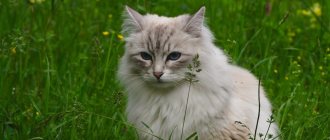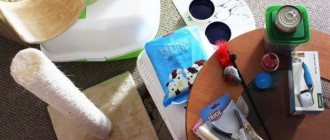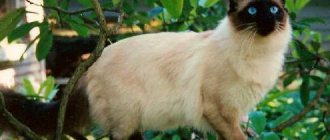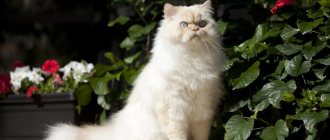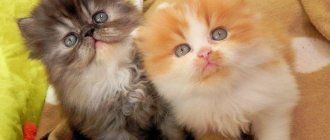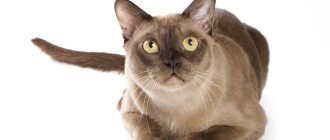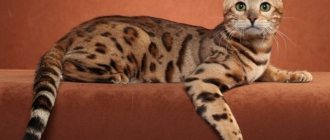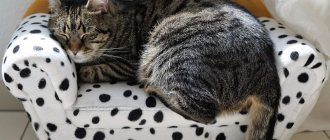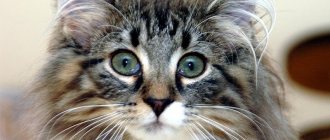History, character and description of the Persian Color Point breed
Color-points have come to their current appearance as a result of many years of selection. And in 1955 the breed received official recognition. They are classified in the Persian group because they have the long hair and body structure characteristic of the Persians. They have large heads and small ears, almost invisible due to their luxurious fur. They are squat and wide-boned. But the eyes are heavenly blue, inherited from the ancestors of the Siamese breed. As well as the color of the face, dark markings on the paws, tail (fluffy, like Persians), and ears. The Persian Colorpoint has a very long coat. For some it reaches ten centimeters. The color of a breed is determined not by the overall color of their coat, but by the color of their spots. The most popular is with dark brown markings. The main color of the fur can be ivory, and on the chest and belly it can be almost white. The spots are the color of dark chocolate. The dark mask on the muzzle reaches the ears and completely hides the eyes and truly Persian nose. But cats of this breed can also have a striped, smoky, or tortoiseshell color. But the eyes remain blue. In total, there are about two dozen colors of modern representatives of this breed.
What is the character of the Persian color point? And his ancestors took care of him. They, like the Persians, are completely domestic. But, Siamese “relatives” are reflected in excessive curiosity, activity and intelligence, and sometimes even cunning.
Description of the Himalayan cat breed
The Himalayan cat is medium or large in size, weighing 4-6 kg. Adult cats can weigh more.
Most international felinological organizations provide a single breed standard for Himalayan, Persian and exotic shorthair cats. The only difference is the length and color of the coat. So, a detailed description of the Himalayan cat according to TICA:
- The head is round, wide, smooth dome shaped, medium to large in size, but proportional to the body. Powerful, wide jaws with excellent bite. Strong chin. Full and defined cheeks. Short, wide, full and flattened muzzle;
- Ears – wide-set, small with rounded tips;
- The eyes are large, round, slightly protruding, widely set. Eye color is as important as shape and size: all shades of blue;
- The nose is equal in width and length, snub-nosed, open nostrils. In profile, the nose is level with the forehead and chin;
- Body: Cobby type, strong, well rounded belly, medium to large size. Short, thick and muscular neck, low chest;
- Paws – short and straight, large bones, well-developed strong muscles, large and round paw pads;
- Tail – proportional to body length and straight;
- The coat of the Himalayan cat is a thick undercoat that gives volume, a fluffy collar, and long throughout the body.
Character
Colorpoint cats are balanced, sedate, gentle and affectionate cats. They would rather sit in your arms than climb the curtains onto the ceiling. The Himalayan cat is able to subtly sense the mood of the owner and adapts to it. These are very smart animals. They love affection and care, but are not demanding. If a Himalayan cat wants your attention, he will simply meow quietly and look intently into your eyes.
However, more active Siamese genes appear against the background of the calm Persian character. Himalayan kittens are very playful and are especially attracted to paper. They are well suited for families with children, because they can play and calmly soak up the sun. These cats are also friendly to other animals.
Care and health
The features of caring for a Himalayan cat are the same as for a Persian cat. This involves daily and thorough brushing of the coat. In addition, due to their flattened muzzle, their tear duct is disrupted. As a result, they "cry" more often and need to wash their eyes daily.
The Himalayan cat surprisingly loves to swim, and it is useful for them to wash away the secretions of the sebaceous glands. Otherwise, the cat's fur will be greasy and unsightly.
The Himalayan cat also inherited from the Persians a tendency to certain diseases. The most common type is polycystic kidney disease. A flattened nose makes these cats more susceptible to respiratory infections and makes breathing difficult. Himalayans also often have problems with the skin, eyes and liver.
Feeding
Most of these potential diseases can be prevented through proper nutrition. Himalayan cats are prone to obesity, so you need to carefully monitor their diet. It is recommended to feed Himalayan cats dry or wet food. It contains the necessary amount of nutrients and vitamins. With natural feeding, it will be more difficult to provide the cat with all the necessary microelements. But his health and appearance depend on this.
The average life expectancy of a Himalayan cat is 12 years.
Color
How to determine that this is a Himalayan cat and not a Persian? Its main distinguishing features are its colorpoint color and deep blue eyes. According to the standard, there must be a clear contrast between the background and the point color. Points cover the ears, paws, tail and muzzle. It is this color that determines the color of the Himalayan cat. Sometimes points can have a tabby or tortie pattern.
In general, different shades of color of the Himalayan cat (colorpoint) are allowed. Most Popular:
- Blue (blue-point) – standard,
- Lilac – diluted blue, body color is whiter and brighter,
- Seal point - dark brown points, paw pads - dark brown,
- Chocolate – chocolate brown points, the body is lighter and brighter than that of the seal point. Paw pads are pink,
- Red - inherited only from a cat with red points,
- Cream – slightly paler than red.
The most difficult breed to breed is a Himalayan cat with chocolate and lilac points. Because for this it is necessary that both parents be the same color.
The following photos show what a Himalayan cat looks like:
Attachment to family
Unlike Siamese cats, which have an unbalanced character, color-point cats are reasonable, sociable and calm. They love to be the center of attention and do their best to attract it. They are demanding of their owners and will not forgive a neglectful attitude towards themselves. Both a small kitten and an adult cat do not like to be left alone for a long time. Although, if you make sure that your pet has enough toys, a scratching post house with shelves, she is quite capable of staying in the apartment alone. Do not look at the fact that cats of this breed look clumsy in appearance. They love to run and play for a long time. This is important if you have children. They can have a great time together. They are not silent like Persian cats, but they are not as talkative as Siamese cats. If you are not the owner of a country mansion with an area where your pet can walk, then your cat will do just fine with walks on the balcony.
But one thing is important. These cats require one thing from their owners - attention. Giving your affection and affection in return. She can lie on your lap for long hours, purring with pleasure, and she will not care about your current affairs at all. The main thing is that she is happy, and her owner loves her.
Name for Himalayan cat
These animals resemble soft plush toys, so they need to choose appropriate nicknames.
Name for a girl: Busya, Bonya, Aziza, Bonbon, Gucci, Grace, Lucky.
Boy's name: Dandy, Misha, Adam, Morpheus, Mickey, Oscar.
How much does a Himalayan kitten cost?
- The price in Russia is from 7,000 to 30,000 rubles.
- Price in Ukraine – from 800 to 5000 hryvnia.
It is better to buy a kitten from a professional nursery, where there is a guarantee that the animal is healthy and purebred.
A variety of Persian cat with a color similar to the Siamese was called the Himalayan breed. Such cats are quite strong, with developed muscles and a powerful skeletal system. The pets have a soft, easy-going character, fluffy coats, and blue eyes. They are calm and child-friendly.
Content
Care and care
Long-haired Persian Colorpoints are extremely demanding in care. Cats need to be bathed frequently and thoroughly brushed. They take water procedures calmly, and some even love them. The cat should be washed with a special shampoo, and under no circumstances with soap. Then you simply won’t comb their luxurious fur. Sometimes cats start to darken. For young pets, this can be a serious disadvantage at shows.
Cats can darken for genetic reasons and due to individual physiology. If a cat lives in a warm place, its coat is lighter. The temperature should be at least 20, but not more than 30 degrees Celsius. In extreme heat, your cat may begin to shed. Try to prevent your pet from spending a lot of time in the cold, or looking around on the balcony.
About the breed
There are three varieties of the breed:
- Old English.
- Modern European.
- Extreme (exotic).
- The body is large or medium, massive.
- Thick tail.
- Large, rounded head.
- Long wool.
- The weight of females is from 3 to 7 kg, males weigh more.
- Large, round, widely spaced eyes.
- The coat color can be: black, blue, smoky, chocolate, cream, red, white, tortoiseshell, multi-colored.
Read here Turkish Van - 125 photos, video description of appearance and standards, character typical of the breed
Popular colors
Among all cat breeds, Persians occupy 1st place in the number of colors, or points (it is close to a hundred, and breeders continue to experiment with shades).
There are cats in white, cream, black, tortoiseshell, chocolate, red and blue. The body of some animals is covered with monochromatic (solid) wool, while the fur coat of others has several different shades (2-3). The color can be simple (the color of the coat matches the color of the undercoat) or complex (the fur hairs differ in color).
The following points are the most common:
- Classic or solid. This group includes tortoiseshell cats and individuals with uniform hair color. Tortoiseshell is a combination of red and black. Only females can have it. It has been established that animals with this coat color can rarely produce offspring, so their numbers are small.
- Silver or smoky. The base of the hair is light and the end is dark.
- Tabby. The animal's fur has alternating stripes, rings and marks, often red. Such animals have yellow, less often blue eyes.
- Agouti. Each hair is colored with alternating light and dark stripes.
- Chinchilla. 87.5% of the hair length is light in tone, the tip (12.5%) is dark. Cats with this color became common at the end of the 20th century.
- Two-color, or bicolor (have 2/3 white and 1/3 chocolate, lilac, black, blue, red or cream color).
- Calico. Tricolor animals, on the coat of which areas of white color alternate with cream and blue or red and black.
There is also a color point color. The cats' bodies are light, and their muzzle, tail and paws are dark. Some scientists call such Persians Himalayan and classify them as a separate breed.
What does genetics have to do with it?
Many people are probably wondering: how did it happen that all the representatives of this group are colored so uniquely? To answer this question, you will have to go back many decades and remember that cats became the object of attention of specialists in the second half of the 19th century. The British then began to perceive them as purebred animals and specially breed certain species.
The Siamese and Persian cats marked the beginning of the official registration of cat breeds. Later they became the progenitors of many modern cat breeds, including color points. Siamese cats came to Europe in 1870 and became favorites of many families. Blue eyes and unusual coloring are what attracted me in the first place.
Some scientific facts.
The color of the coat and eyes depends on a polymer pigment called melanin. It is formed from the amino acid tyrosine under the influence of the enzyme tyrosinase. It is this enzyme that is controlled by the gene that determines color, which is called Color. This gene is designated by the letter “C”. When the C gene is mutated, no active tyrosinase is produced and the pigment does not appear.
Scientists have discovered the Himalayan cs, or ch gene, which is also formed from a mutated C gene. But in this case, the enzyme tyrosinase becomes heat-sensitive, that is, depending on the temperature, it changes its activity: at high temperatures, tyrosinase is inactive, and as soon as the temperature drops, melanin in the cells it begins to produce and color the cooled areas of fur in darker colors.
